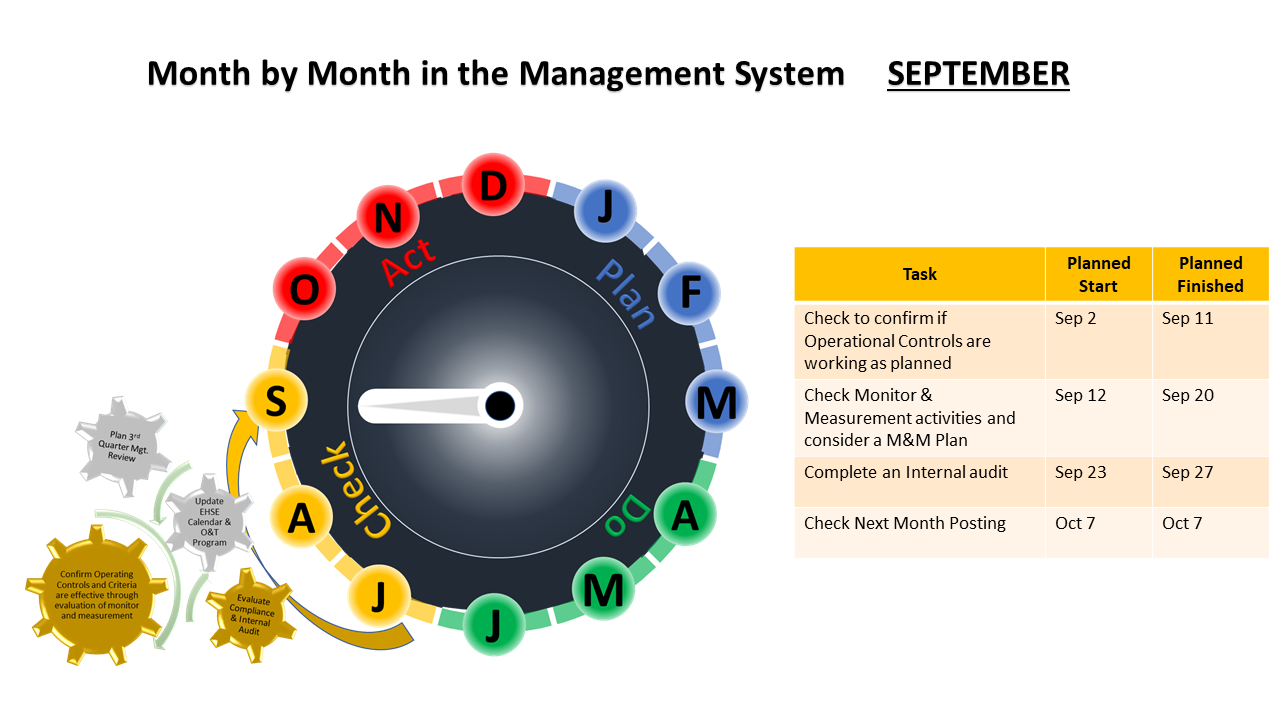Archive for September 2019
September Management System Tasks
September
Fall is here and as you get closer to 4th quarter, it’s time to finish taking care of this year’s business. There are three important checking activities:
Operational Controls – Are they working?
It’s easy to set up work instructions, standard operating procedures, signs, etc….but are they controlling the unintended impacts they were set up to control? For all the work to set up a thorough control, it’s worth the time to check effectiveness. Do this ahead of the internal audit and prior to your evaluation of monitor and measure so you close up any obvious gaps.
Going forward the checking of operational controls is part of the PDCA when controls are set.
- Plan the control needed – For example, an SOP for separating and stacking cardboard (a key characteristic) on the shop floor
- Do by documenting the control – Review accuracy with the shop floor, and then train affected employees and contractors to follow it. Do both the Supervisors and operators say the proposed SOP for cardboard will work? Do they understand the intent?
- Check by reviewing the operation – Verify if the SOP is followed and all affected cardboard is separated and stacked as planned. Make sure you evaluate the methods to track amount of cardboard separated and stacked so the monitor and measure for this key characteristic is established.
- Act by reporting on the performance – Are there other improvements to the SOP you can plan or are there improvements to how cardboard is collected?
Monitor and Measurement – Are you following a plan?
The monitor and measurement of key characteristics associated with the system is really one of your last checking activities. In our experience organizations benefit greatly from the documented monitor and measure plan because the standard requires:
- What will be monitored
- How will it be monitored
- How will performance be measured
- When will it be monitored/measured
Remember to identify the Role/Responsibility for completing tasks
- Is there a plan for monitor and measure; simply stated; have you systematically identified the list of characteristics to monitor and measure to achieve the intended goal of continual improvement. If this is not part of the system, make a list and describe how each item is monitored and measured. Most importantly list what is considered a deviation and how is it addressed?
- Check the calibration and preventive maintenance system. Is new or replaced equipment adequately identified? Is key equipment, devices, and gauges calibrated? Do work orders function as planned? When employees or those working on behalf indicate an environmental or safety situation exists does the TAG or request follow a process for timely completion.
Internal Audit – Is it rigorous, independent and up-to-date?
The internal audit should follow the arrangements of the internal audit program. Your internal audit program needs to address frequency, audit methods, planning, reporting, the importance of the business processes and the results of previous audits. Don’t forget for ISO 45001 the need to include consultation arrangements into the audit program.
A robust internal audit program is key; so take the time to plan, schedule auditors and give it the attention it deserves. The results of the internal audit should show you the strengths and any weaknesses in the system. If the conclusion of the audit identifies a need for action, a robust program includes the organization commitment to investigate those weaknesses to prevent recurrence.
Periodically use a fresh pair of eyes. There are any number of ways to do this including inviting a sister organization to audit, using an outside auditor, or simply having new auditors in your organization qualified and given the audit task. Don’t be stuck on “if it wasn’t found before, it cannot be a legitimate audit finding”.
Finally, if the internal audit checklist has not been reviewed and updated, it’s time to ensure all the criteria for the audit meets all of the requirements in the standards and the procedures. While any checklist has to be manageable, it’s likely if the checklist hasn’t been reviewed, it may not address the newest requirements for ISO 14001, ISO 45001, and ISO 50001. Now is a good time for the audit team to gather, review the checklist and recommend improvements.

